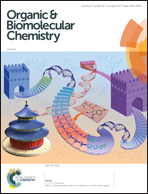Efficient active-template synthesis of calix[6]arene-based oriented pseudorotaxanes and rotaxanes†
Abstract
A substrate can modify its chemical features, including a change of its reactivity, as a consequence of non-covalent interactions upon inclusion within a molecular host. Since the rise of supramolecular chemistry, this phenomenon has stimulated the ingenuity of scientists to emulate the function of enzymes by designing supramolecular systems in which the energetics and selectivity of reactions can be manipulated through programmed host–guest interactions and/or steric confinement. In this paper we investigate how the engulfment of a positively charged pyridinium-based guest inside the π-rich cavity of a tris-(N-phenylureido)calix[6]arene host affects its reactivity towards a SN2 reaction. We found that the alkylation of complexed substrates leads to the formation of pseudorotaxanes and rotaxanes with faster kinetics and higher yields with respect to the standard procedures exploited so far. More importantly, the strategy described here expands the range of efficient synthetic routes for the formation of mechanically interlocked species with a strict control of the mutual orientation of their non-symmetric molecular components.
![Graphical abstract: Efficient active-template synthesis of calix[6]arene-based oriented pseudorotaxanes and rotaxanes](/en/Image/Get?imageInfo.ImageType=GA&imageInfo.ImageIdentifier.ManuscriptID=C7OB01642E&imageInfo.ImageIdentifier.Year=2017)


 Please wait while we load your content...
Please wait while we load your content...